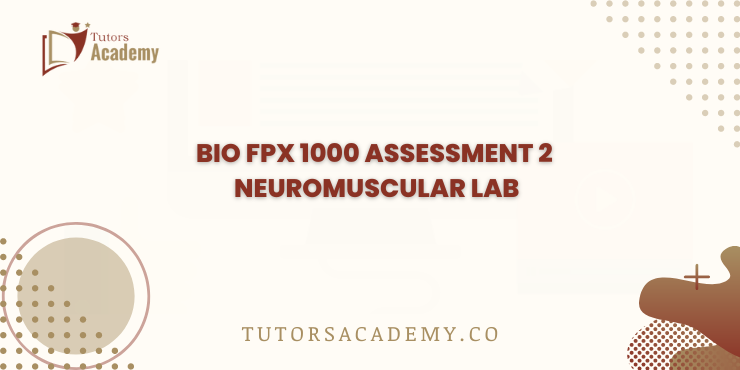
- BIO FPX 1000 Assessment 2 Neuromuscular Lab
Homework: Neuromuscular Lab
Neuromuscular exams are essential in assessing the whole body, especially the nervous system and muscular performance, with a view to helping diagnose and treat neuromuscular diseases. These tests evaluate the degrees of muscle weakness, reflexes, coordination, and sensations, as stated by Ishida et al., 2023. In this assessment, neuromuscular assessment is placed at the forefront.
Importance of Eye Exams
Eye check-ups are crucial because they help check the health of the eyes and keep the vision sharp. The yearly eye exams involve a review of the visual abilities, eye muscles, peripheral vision, and eye internal pressure, hence early detection of the problem. Ophthalmologists can check for various issues containing the retina and optic nerve, therefore early diagnosis and management. Annual checkups also involve looking for changes in vision and the prescription of glasses where necessary.
Further, they create a chance to talk to an ophthalmologist about any issues or symptoms related to vision and get recommendations for its proper care and preservation (Jotte et al., 2023). It is, therefore, essential to continue exercising precautions towards the eyes; this is where we sometimes hear people say they see blur; they should visit the optometrist. So, through these ways, people should be encouraged to take great care of their eyes so that if complications occur in the future, necessary steps should be taken.
Lack of vision checkups also increases the likelihood of missing other issues concerning the eyes that are likely to precipitate in the long run. Unless they are treated promptly, the above diseases cause irreversible visual impairment or even blindness. The disease screening that comes with eye examination allows the ophthalmologist to diagnose and manage ocular problems early and, in turn, enables patients to maintain their vision and improve their quality of life (Elam et al., 2022). Evaluating the eyes every year is very important to ensure that the eyes are healthy and there are no signs of complications in the future.
Why Reflexes Are Measured During the Diagnostic Exam?
Reflex testing is often done during eye examinations because it provides valuable information about identifying the causes of neuromuscular disorders. Doctors do so to check on the nervous system as a method of confirming its operation. It is a type of motor response that does not require any decision-making and can be pathological and signify neurological problems such as nerve damage or dysfunction (Shahrokhi & Asuncion, 2023). Reflexes are good indicators of neurological function and any abnormalities that may be present, and through reflex testing, doctors can get information about a patient’s neurological status.
BIO FPX 1000 Assessment 2 Neuromuscular Lab
Whenever a doctor fails to measure reflexes during a diagnostic exam, he or she will forgo critical indices of neurological integrity or the lack thereof. This can lead to some features of a neurological disorder not being identified at the right time, thus consequences that may entail wrong treatment methods or worsening of the illness without the proper treatment (Schmidt et al., 2021). Therefore, evaluating reflexes is crucial in an examination that would provide a broad outlook to give an accurate diagnosis of neurological health conditions.
Patient Examination
Patient 1
An example of personal involvement would be Derrick Mendez, the twenty-two-year-old man who sought a physical check-up. The laboratory findings indicate the following results for his tests: The laboratory findings indicate the following results for his tests:
Color Blindness Test
It is concluded from the test that the colors cannot be discriminated.
Astigmatism Test
As for the dark lines, none were observed on any of the stars in the given spectrum.
Visual Equity Test
The visual equity tests received 100 percent, an A-grade performance.
Knee Jerk Reflex
These included such a normal response as, for instance,
Pupillary Light Reflex
A shift of sorts was seen with a gusto.
Possible Resolution
The results of the tests are all lognormal, but the colorblindness test is off. Iris anomalies are not curable, but Derrick can improve his quality of life through the prescription of color-corrective lenses (Rabin et al., 2022).
Patient 2
A 45-year-old woman named Maria Heinz reported having trouble reading and seeing objects located close to her, and she suffers from headaches. Below are the descriptions of her laboratory test results: Below are the descriptions of her laboratory test results:
Color Blindness Test
The test proves that the colors were well discriminated against under normal conditions.
Astigmatism Test
Two symptoms were noted: There was the appearance of two dark lines.
Visual Equity Test
The visual equity test was 20/30 on the Snellen chart.
Knee Jerk Reflex
The response was typical.
Pupillary Light Reflex
Starting from Work Package 1, a quick change was observed, with the team average score increasing to above 90, compared to an 81% Work Package 1 score.
Possible Resolution
The lab tests found that Maria has astigmatism, and her visual acuity is worse than normal. These issues can be solved with toric contact lenses, eyeglasses, and magnifiers (Goggin, 2022).
Patient 3
Edward Norton, a 70-year-old man, complains of the following symptoms: muscle weakness and blurred vision. Below are his laboratory test findings: Below are his laboratory test findings:
Color Blindness Test
In the test, we learned that colors were distinguishable, as attested by the test.
Astigmatism Test
As for the other case, no dark line was observed.
Visual Equity Test
The visual equity tests had 20/80 as the number of scores.
Knee Jerk Reflex
There was no record of any leg activity at all during her stay at the hospital.
Pupillary Light Reflex
No change was observed.
Possible Resolution
As presented above, the results reveal that the knee jerk and pupillary light reflexes are abnormal, which means that there are problems with neurons. Pharmacological and physical therapy are needed to rehab the knee jerk reflex, as well as vision therapy and medications for pupillary reflex abnormalities.
Conclusion
Regular eye checkups are crucial in early diagnosis of eye diseases and related systemic diseases. Annual eye examinations should be a priority because they can prevent lays and, therefore, lower general treatment costs. Reflexes are critical features during eye checkups because they give the doctor information on other neurological problems that may need intervention. Generally, a lack of ideas about eye exams and reflex assessments can lead to terrible outcomes.
Read more about our sample BIO FPX 1000 Assessment 5 Homework Genetics Lab for complete information about this class.
References
Elam, A. R., Tseng, V. L., Rodriguez, T. M., Mike, E. V., Warren, A. K., Coleman, A. L., Aguwa, U., Alabiad, C., Briceno, C., Capo, H., Contreras, M., Edmond, J., Ervin, A.-M., Fountain, T., Friedman, D., Gao, J., Gordon, L., Harewood, J., Kitayama, K., & Knight, O. (2022). Disparities in vision health and eye care. Ophthalmology, 129(10), e89–e113.
https://doi.org/10.1016/j.ophtha.2022.07.010
Goggin, M. (2022). Toric intraocular lenses: Evidence‐based use. Clinical & Experimental Ophthalmology, 50(5), 481–489.
https://doi.org/10.1111/ceo.14106
Ishida, A., Bazyler, C. D., Suarez, D. G., Slaton, J. A., White, J. B., & Stone, M. H. (2023). The difference between several neuromuscular tests for monitoring resistance-training-induced fatigue. Journal of Sports Sciences, 41(3), 209–216.
https://doi.org/10.1080/02640414.2023.2207852
Jotte, A., Vander Kooi, W., & French, D. D. (2023). Factors associated with annual vision screening in diabetic adults: Analysis of the 2019 national health interview survey. Clinical Ophthalmology, Volume 17, 613–621.
https://doi.org/10.2147/opth.s402082
Rabin, J., Silva, F., Trevino, N., Gillentine, H., Li, L., Inclan, L., Anderson, G., Lee, E., & Vo, H. (2022). Performance enhancement in color deficiency with color-correcting lenses. Eye.
https://doi.org/10.1038/s41433-021-01924-0
Schmidt, W. U., Lutz, M., Ploner, C. J., & Braun, M. (2021). The diagnostic value of the neurological examination in the coma of unknown etiology. Journal of Neurology.
https://doi.org/10.1007/s00415-021-10527-4
Shahrokhi, M., & Asuncion, R. M. D. (2023). Neurologic exam. PubMed; StatPearls Publishing.
https://www.ncbi.nlm.nih.gov/books/NBK557589/
Zimmerman, B., & Hubbard, J. B. (2019, July 16). Anatomy, deep tendon reflexes (stretch reflexes). Nih.gov; StatPearls Publishing.
